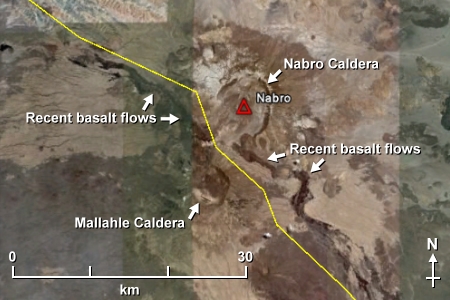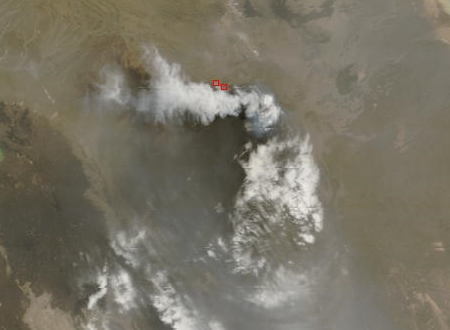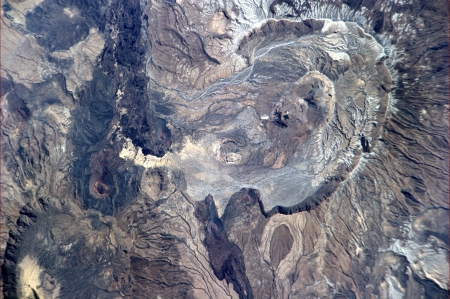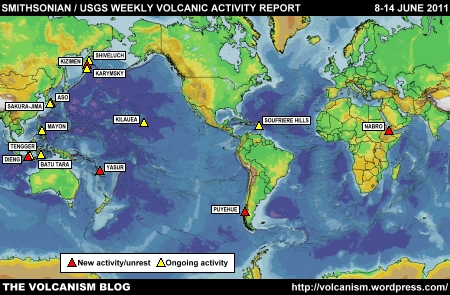Nabro eruption quieter, but continuing 18 June 2011
Posted by admin in activity reports, Africa, Eritrea, eruptions, Nabro.comments closed
The eruption at Nabro is continuing. The announcement by Toulouse VAAC yesterday that the eruption had ‘stopped’ was, as we said at the time, not definitive. The latest from Toulouse (18:00 UTC 18 June 2011) is that the ‘eruption currently gets weaker’ and that the plume is ‘mainly composed of SO2 and water vapor’. The VAAC’s prediction for the next 24 hours (graphic here) is that no ash from this eruption will be detectable from 00:00 UTC on 19 June. Ethiopian Airlines has announced that it will be resuming flights to Khartoum after they were disrupted by the ash cloud from Nabro last week.
At 08:00 UTC this morning NASA’s Terra satellite captured a MODIS image of Nabro showing a small lightish plume with a diffuse ash cloud drifting south from the volcano. Click on the image to go to the original at the NASA Rapidfire site.
News
Ethiopian Airlines flights disrupted by ash cloud from Eritrean volcano – Bloomberg, 14 June 2011
Ethiopian Airlines to resume flights to Khartoum, Sudan, today – Bloomberg, 17 June 2011
Information
Global Volcanism Program: Nabro – summary information for Nabro (0201-101)
Nabro eruption stopped – Toulouse VAAC (updated) 17 June 2011
Posted by admin in activity reports, Africa, Eritrea, eruptions, Nabro.comments closed
The Toulouse VAAC has issued a new volcanic ash advisory since our last update on Nabro was published earlier this morning. The advisory was issued at 06:00 UTC 17 June 2011 and reports that ‘eruption stopped 16/1500Z’, that is, 15:00 UTC on 16 June (an earlier advisory at 00:00 on 17 June had indicated that ‘eruption seems to pause about 15 UTC’).
This is not definitive: the eruption may have ended, or it may simply be in remission for a while. Time will tell.
UPDATE. Stopped? Or not? Irish Weather Online: Nabro volcano erupts again Friday after moderate quake. Busy now, more on this later.
FURTHER UPDATE. Irish Weather Online have retreated somewhat from their claim that there has been a fresh eruption from Nabro today: the title of the post linked to above has been changed from ‘Nabro volcano erupts again Friday after moderate quake’ to ‘Magnitude 5.5 earthquake hits near Nabro volcano’. The story originally reported that ‘a 5.5 magnitude earthquake on Friday morning led to a further increase in volcanic activity’ and that ‘Friday’s eruption has sent a massive ash plume westnorthwest over Sudan threatening to bring further disruption to air traffic in the east Africa region’. Now the claim is simply that ‘a 5.5 magnitude earthquake on Friday morning could lead to a further increase in volcanic activity’, and the tale of the massive plume has quite vanished.
Information
Global Volcanism Program: Nabro – summary information for Nabro (0201-101)
Nabro update, 17 June 2011 17 June 2011
Posted by admin in activity reports, Africa, Eritrea, eruptions, Nabro, volcanoes.comments closed
The most recent volcanic ash advisory for Nabro volcano in Eritrea, issued by the Toulouse VAAC at 18:00 UTC on 16 June 2011, reports that the emissions are ‘mainly composed of SO2’. Satellite images currently show no sign of ash, but there is much evidence of copious sulphur dioxide emission. OMI data (from the ESA’s Support to Aviation Control Service near real time data page) shows the SO2 plume stretching north-west from Nabro, then curving back across Egypt and the Middle East and into central Asia, to reach as far as western China.
Above. Nabro SO2 plume 14-17 June (OMI data, KNMI.FMI/NASA). From ESA SACS.
Yesterday emissions were still vigorous with an upswing in activity which caused renewed flight cancellations in Eritrea’s neighbours to the north and west. The ash advisory issued by Toulouse at 1200 UTC on 16 June reported emissions, ‘mainly SO2 and ice’, at 20,000-40,000 feet (6,000-12,000 metres) altitude. NASA’s Aqua satellite captured a MODIS showing a robust plume from Nabro’s caldera (image below reduced in size – click here or on the image for the original at the NASA Earth Observatory):
Above. Nabro volcano erupting 15 June 2011 (NASA/Aqua).
MODIS hotspots data for the last 24 hours downloaded from the University of Maryland’s Fire Information for Resource Management System (FIRMS) and plotted onto Google Earth suggests a large lava flow has been produced by the current phase of activity, perhaps reaching 16 km west of the caldera. The Google Earth plot is below – click on the image to enlarge (my apologies for the lack of a scale bar: the width of the area in the image is ~22 km).
For a glimpse of what the Nabro caldera looked like before the current eruption, here’s an ISS astronaut photograph taken in (I think – I don’t have the precise date) January this year. Many thanks to Robert Simmon of NASA for providing this image. The image has been rotated 180 degrees from the original to make comparison with later pictures easier (thanks T. W. in the comments). Click on the image for a larger version.
Finally, we have known for sure since Monday that the volcano erupting in Eritrea is Nabro, not Dubbi. So, to clueless news outlets which are still blithely reporting that Dubbi is erupting: shame on you.
News
Eritrea volcano: ash disrupts air travel in East Africa – BBC News, 15 June 2011
Nabro volcano erupts again Thursday – Irish Weather Online, 16 June 2011
Fresh Dubbi eruption threatens ash disruption – Arab News, 17 June 2011
Information
Global Volcanism Program: Nabro – summary information for Nabro (0201-101)
Smithsonian/USGS Weekly Volcanic Activity Report 8-14 June 2011 16 June 2011
Posted by admin in activity reports, Africa, Aso, Batu Tara, Caribbean, Chile, Dieng Volcanic Complex, Eritrea, eruptions, Hawaii, Indonesia, Japan, Kamchatka, Karymsky, Kilauea, Kizimen, Mayon, Nabro, Pacific, Puyehue, Russia, Sakura-jima, Shiveluch, Soufrière Hills, Tengger Caldera, United States, Vanuatu, Weekly Volcanic Activity Reports, Yasur.Tags: Global Volcanism Program
comments closed
The Smithsonian Institution and United States Geological Survey Weekly Volcanic Activity Report, compiled by Sally Kuhn Sennert, has been issued for the week 8-14 June 2011. Another week high in volcanic interest:
- Kizimen: eruptive episode with ash plumes reaching 4-5 km altitude
- Nabro: eruption following an earthquake swarm sent ash to 13.7 km altitude
- Puyehue-Cordón Caulle: eruption continues with continuous ash emission and pyroclastic flows
- Mayon: slight inflation detected at the summit
Click on the map for a larger version (1211 x 784 pixels).
The Smithsonian Institution/United States Geological Survey Weekly Volcanic Activity Report for 8-14 June 2011 is now available on the Global Volcanism Program website. The following is a summary and not a substitute for the full report.
- The current report: Weekly Volcanic Activity Report.
- Previous reports: Weekly Reports Archive.
- The SI/USGS map of volcanoes discussed this week.
New activity/unrest: Aso (Japan), Dieng Volcanic Complex (Indonesia), Kizimen (Russia), Nabro (Eritrea), Puyehue-Cordón Caulle (Chile), Yasur (Vanuatu).
Ongoing activity: Batu Tara (Indonesia), Karymsky (Russia), Kilauea (Hawaii, USA), Mayon (Philippines), Sakura-jima (Japan), Shiveluch (Russia), Soufrière Hills (Montserrat), Tengger Caldera (Indonesia).
Note: ‘a.s.l.’ = ‘above sea level’.
Nabro eruption calming down? 14 June 2011
Posted by admin in activity reports, Africa, Eritrea, eruptions, Nabro.comments closed
[Just a quick update on the Nabro eruption, as I have a busy day today.] Satellite images of Eritrea and Ethiopia this morning seem to show a quieter situation at Nabro, the Eritrean volcano that began erupting on Sunday night and produced an impressive plume yesterday. No sign of such a plume today: on first examination it’s difficult to distinguish any volcanic emissions from surrounding cloud. Below are two images from Sat24.com, showing the situation at 07:30 UTC this morning. The likelihood is that this event is a fissure eruption which had an explosive component at an early stage. Nabro has seen such fissure activity before, and perhaps not that long ago (in geological terms), but with so much of this remote and little-studied volcano’s history and character being unknown it’s difficult to state anything for certain.
Above. Visual image of Eritrea/Ethiopia, 14 June 2011 07:30UTC (Sat24.com/Eumetsat/Met Office). Click on the image for full-size version.
Above. Infrared image of Eritrea/Ethiopia, 14 June 2011 07:30UTC (Sat24.com/Eumetsat/Met Office). Click on the image for full-size version.
The latest volcanic ash advisory from Toulouse VAAC, issued at 06:00 UTC, reports ‘continuous emission’ from the volcano with ash at between FL200 (20,000 feet/6000 metres altitude) in the vicinity of the eruption to FL450 (45,000 feet/13,700 metres altitude), predicted to reach at its extremes as far west as Chad and as far north as Uzbekistan by this afternoon.
Information
Global Volcanism Program: Nabro – summary information for Nabro (0201-101)
Official Eritrean statement on the Nabro volcanic eruption 13 June 2011
Posted by admin in activity reports, Africa, Eritrea, eruptions, Nabro.comments closed
A statement on the Nabro eruption has just appeared on Shabait.com (‘Serving The Truth’), the news and information website for the Eritrean Ministry of Information: Volcanic eruption witnessed in the tip of Southern Red Sea Region. Text as follows:
Assab, 13 June 2011 -A volcanic eruption was witnessed in the tip of the Southern Red Sea region at 9 p.m. yesterday.
Reports indicated that the eruption that took place in 4 different areas around Afambo, Nebro and Sireru causing a 5.7 rector scale earth tremor.
The ensuing dust is covering hundreds of kilometers in the area, and that the quake has been heard in the greater portion of the region as a whole, according to reports.
The Southern regional Administration disclosed that the Government has moved the inhabitants in the area to a safe place, in addition to providing them with the necessary care. No damage has so far been inflicted to human life , the Administration added.
Although similar earthquake incidents were witnessed from time to time in previous years, yesterday’s tremor was of higher scale that led to volcanic eruption.
[End of the statement.]
Eritrea eruption update: Nabro volcano erupts (updated) 13 June 2011
Posted by admin in activity reports, Africa, Dubbi, Eritrea, eruptions, Nabro.comments closed
Ever since news of the eruption in Eritrea began to seep out early today the identity of the volcano responsible has remained unclear. Dubbi was a prime candidate (and that’s the one Toulouse VAAC went for [UPDATE – Toulouse VAAC has now confirmed that the volcano is Nabro) but with the release of high definition MODIS satellite imagery from the Aqua satellite it is now pretty clear that the eruption originates at Nabro (as Mark Dunphy at Irish Weather Online and several commenters at Eruptions and Earthquake-Reports had suggested, so due acknowledgements to them for their insight). The image below comes from Aqua/MODIS, 10:45UTC 13 June 2011.
Nabro is a stratovolcano reaching to 2,218 metres a.s.l., truncated by nested calderas of 5 km and 8 km diameter, the latter caldera having a wide breach to the SW. Although Nabro has no recorded Holocene eruptive activity, the GVP (from which this description comes) notes that ‘ Some very recent lava flows were erupted from NNW-trending fissures transverse to the trend of the Nabro volcanic range’, so if the current activity is from the Nabro complex it does not necessarily represent the surprise re-awakening of the volcano after millennia of dormancy. Wiart and Oppenheimer (2005) identify these ‘recent basaltic flows’ as originating from ‘Vents … located between Nabro and Mallahle calderas, and fed in part from fissures aligned perpendicularly to the NVR [Nabro Volcanic Complex] axis’ (p. 104), although, working with strictly limited data, they do not venture a date for these flows. Satellite imagery shows these flows as weathered, but fresher and distinctly darker than surrounding material.

Above. Map of the Nabro Volcanic Complex from Google Earth, incorporating information from map in Wiart & Oppenheimer (2005), p. 106. Yellow line is the Eritrea/Ethiopia border.
Toulouse VAAC has issued a new ash advisory at 1200UTC for the volcano it is still calling Dubbi, reporting ash at altitudes varying from FL200 (20,000 feet/6000 metres altitude) in the vicinity of the eruption to FL450 (45,000 feet/13,700 metres altitude) to the north, where the plume curves back around to the east (map in .png format) after spreading across Ethiopia to reach Israel, Jordan, northern Saudi Arabia and western Iraq. In Israel the Jerusalem Post is reporting that the ash may disrupt flights from Eilat in the south of the country.
Erik Klemetti has an update on the Eritrea event at Eruptions (just before he goes away on honeymoon too, so congratulations and all good wishes to the happy couple). And have a look at this video from Earthquake-Report.com at YouTube.
The International Big News Machine is now catching up with this eruption. BBC News and Associated Press have both published reports in which they confidently identify the volcano concerned as Dubbi, based on the information from Toulouse VAAC. Reuters says it’s Dubbi, mentions that some people think it might be Nabro, then goes right back to talking about Dubbi again. And U.S. Secretary of State Hilary Clinton, attending some international get-together or other in Addis Ababa, is flying out early because of the ash cloud blowing in from Eritrea.
UPDATE: Toulouse VAAC has confirmed that the volcano erupting is Nabro in its latest volcanic ash advisory (issued 18:00 UTC); and via Twitter comes this photograph of Nabro’s plume, taken from ~200 km away by Mark Haldane.
Reference
Pierre Wiart and Clive Oppenheimer, ‘Large magnitude silicic volcanism in north Afar: the Nabro Volcanic Range and Ma’alalta volcano’, Bulletin of Volcanology, vol. 67, no. 2 (2005), pp. 99-115 [DOI: 10.1007/s00445-004-0362-x]
News
Eritrean volcanic ash may affect some flights from Eilat – Jerusalem Post, 13 June 2011
Nabro volcano in Eritrea erupts, ash cloud spreads – Irish Weather Online, 13 June 2011
VAAC: eruption underway at Dubbi volcano in Eritrea – Channel 6 News, 13 June 2011
Eritrea eruption: Lufthansa cancels flights due to ash – BBC News, 13 June 2011
Airlines watching East Africa volcanic ash cloud – Associated Press, 13 June 2011
Clinton cutting short Africa trip because of volcano eruption in Eritrea – Washington Post, 13 June 2011
Volcano erupts in Eritrea after earthquakes: VAAC – Reuters Africa, 13 June 2011
Information
Global Volcanism Program: Nabro – summary information for Nabro (0201-101)
Eruption in Eritrea: 1,000 km plume 13 June 2011
Posted by admin in activity reports, Africa, Dubbi, Eritrea, eruptions, Nabro.comments closed
Infrared image of Eritrea eruption plume, 13 June 2011 07:30UTC (Sat24.com/Eumetsat/Met Office)
A significant eruption is evidently under way at Dubbi volcano (although there is still some doubt about the precise identity of the volcano involved [UPDATE – it’s Nabro, not Dubbi: see update here]) in Eritrea, north-east Africa. An earthquake swarm occurred during during the evening of 12 June, with moderate quakes followed by two strong quakes of magnitude 5.7, all around 10 km depth:
12 June 2011 15:37UTC: mag 5.1 Eritrea-Ethiopia region (USGS info)
12 June 2011 19:21UTC: mag 5.0 Ethiopia (USGS info)
12 June 2011 20:32UTC: mag 5.7 Eritrea-Ethiopia region (USGS info)
12 June 2011 21:03UTC: mag 5.7 Eritrea-Ethiopia region (USGS info)
A volcanic eruption appears to have begun around the time of the last 5.7M earthquake, at about 21:00 UTC. Toulouse VAAC identified the volcano as Dubbi and issued two Volcanic Ash Advisories so far for this eruption today: at 04:00 UTC the eruption was reported to have started at 23:00 UTC on 12 June 2011, and to have produced a plume between FL150/300 (15,000-30,000 feet/4,500-9,000 metres altitude), while at 06:00 UTC the volcano was described as being in ‘continuous emission’ with ash at FL300/450 (30,000-45,000 feet/9,000-13,500 metres altitude) and trending W/WNW.
Eumetsat image, 08:00UTC. Thanks to Eruptions commenter Shérine France for providing the link. Click on the image for the original.
Dubbi was responsible for the largest known volcanic eruption in Africa in historical time, in 1861: more than 100 people were killed, ash fell more than 300 km from the volcano and the lava flows travelled 22 km and reached the Red Sea. Other possible candidates for the current eruption include Nabro and Mallahle.
UPDATE. Via Oxford volcanologist David M. Pyle’s Twitter,here are MODIS images of the Eritrea volcanic ash plume. Thanks to Clive Oppenheimer of Cambridge University (via Earthquake-Reports) we have a useful news report from the Cambridge Geography Department site related to Clive’s Eruptions that Shook the World book: Eruption in Eritrea, 12 June 2011. ‘Loud explosions were heard in Afdera, across the border in Ethiopia, and ashfall is reported as far as Mekele in Tigray province’ … the identity of the volcano is still to be confirmed – Nabro or Dubbi? And more coverage can be found at the Simplement Géologie blog (in French), Séisme et éruption volcanique en Éritrea, Afrique, and at Volcano Blog, Eruption of Dubbi in Eritrea. The Irish Weather Online site has identified the volcano as Nabro rather than Dubbi, on the grounds that satellite images show plume is originating at a point too far south to be the latter. Nabro has no recorded Holocene eruptive activity, so its awakening would be an interesting development. Confirmation one way or the other is still awaited.
ACKNOWLEDGEMENTS. A major source of information on this eruption has been the comment thread at this post over at Dr Erik Klemetti’s Eruptions blog. And excellent ongoing coverage is available at Earthquake-Report.
News
Eritrea volcano eruption: ash plume length exceeds 1,000 km (630 miles) – Earthquake-Report, 13 June 2011 (title changes as the post is updated)
Quake storm hits Ethiopia-Eritrea – Stuff.co.nz, 13 June 2011
Information
Global Volcanism Program: Dubbi – summary information from the GVP for Dubbi (0201-10=)





















